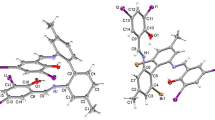Abstract
On basis of earlier experimental experience, the transfer of protons in salts of the organic cation-inorganic anion type occurs primarily through directional arrangement of the anion-anion type short hydrogen bonds. The submitted work presents the preparation of quaternary pyridinium salts of inorganic hydrogen anions in the absence of solvent molecules in their crystal structure. These substances can form only the above-described anion-anion type hydrogen bonds; in addition, the absence of solvate anions increases the stability of the prepared compounds. A total of six substituted pyridinium salts were prepared, four of which have not been described yet: 1,2,4,6-tetraphenylpyridinium perchlorate, 1-benzyl-2,4,6-trimethylpyridinium perchlorate, 1,4-dimethylpyridinium hydrogen sulphate, 1,4-dimethylpyridinium dihydrogen phosphate, 1,4-dimethylpyridinium hydrogen sulphate, and 1,2-dimethyl-5-ethylpyridinium dihydrogen phosphate. Three of these substances were characterised by X-ray structural analysis: 1,2,4,6-tetraphenylpyridinium perchlorate crystallises in the orthorhombic system, space group Pbca; 1-benzyl-2,4,6-trimethylpyridinium perchlorate crystallises in the monoclinic system, space group P21/c; and 1,4-dimethylpyridinium dihydrogen phosphate crystallises in the monoclinic system, space group C2/c. This structure contains an oriented anion network bond by short anion-anion type hydrogen bonds with the donor acceptor lengths of 2.567(3) Å and 2.557(3) Å and thus fulfils the requirements of a good proton conductor.
Similar content being viewed by others
References
Altomare, A., Cascarano, G., Giacovazzo, C., Guagliardi, A., Moliterni, A. G. G., Burla, M. C., Polidori, G., Camalli, M., & Spagna, R. (1997) SIR-97 [computer software]. Bari, Italy: Institute of Crystallography.
Hooft, R. W. W. (1998) COLLECT [computer software]. Delft, The Netherlands: Nonius.
Kaman, O., & Havlíček, D. (2005) Determination of crystal orientation of protonated diazabicyclooctane dihydrogenphosphate using powder diffraction technique in relation to study of proton conductors. Materials Structure, 12, 77–81. (in Czech)
Kaman, O., Smrčok, L’., Císařová, I., & Havlíček, D. (2011) Dihydrogen phosphate and hydrogen sulphate of 1,4-dimethyl-1,4-diazabicyclo[2.2.2]octane-1,4-diium: Crystal structures, hydrogen bonding and infrared spectra. Journal of Chemical Crystallography, 41, 1539–1546, DOI: 10.1007/s10870-011-0137-0.
Mehta, V., & Cooper, J. S. (2003) Review and analysis of PEM fuel cell design and manufacturing. Journal of Power Sources, 114, 32–53. DOI: 10.1016/s0378-7753(02)00542-6.
Li, M. Q., Shao, Z. G., & Scott, K. (2008) A high conductivity Cs2.5H0.5PMo12O40/polybenzimidazole (PBI)/H3PO4 composite membrane for proton-exchange membrane fuel cells operating at high temperature. Journal of Power Sources, 183, 69–75. DOI: 10.1016/j.jpowsour.2008.04.093.
Němec, I., Macháčková, Z., Teubner, K., Císařová, I., Vaněk, P., & Mička, Z. (2004) The structural phase transitions of aminoguanidinium(1+) dihydrogen phosphate—study of crystal structures, vibrational spectra and thermal behaviour. Journal of Solid State Chemistry, 177, 4655–4664. DOI: 10.1016/j.jssc.2004.08.010.
Otwinowski, Z., & Minor, W. (1997) Processing of X-ray diffraction data collected in oscillation mode. In C. W. Carter, Jr., & R. M. Sweet (Eds.), Methods in enzymology (Vol. 276, pp. 307–326). New York, NY, USA: Academic Press.
Rikukawa, M., & Sanui, K. (2000) Proton-conducting polymer electrolyte membranes based on hydrocarbon polymers. Progress in Polymer Science, 25, 1463–1502. DOI: 10.1016/s0079-6700(00)00032-0.
Sheldrick, G. M. (1997) SHELXL-97, Program for crystal structure refinement from diffraction data [computer software]. Göttingen, Germany: University of Göttingen.
Smrčok, L’., Havlíček, D., Kaman, O., & Rundlöf, H. (2009) 1,4-diazabicyclo[2.2.2]octane-1,4-diium dihydrogen phosphate monohydrate from X-ray and neutron data. Zeitschrift für Kristallographie, 224, 174–178. DOI: 10.1524/zkri.2009.1127.
Spek, A. L. (1999) Platon [computer software]. Utrecht, The Netherlands: Utrecht University.
Taraba, L. (2012) Proton conductivity of powder samples. Bc. Thesis, Charles University in Prague, Czech Republic.
Urban, J., & Volke, J. (1994) 1,2,4,6-Substituted pyridinium derivatives-synthesis and properties. Collection of Czechoslovak Chemical Communications, 59, 2545–2561. DOI: 10.1135/cccc19942545.
Volke, J., Urban, J., & Volkeová, V. (1992) The influence of substitution on the reduction mechanism and stability of reduction intermediates in 1,1′-phenylene-, 1,1′-diphenylene- and 1,1′-polymethylene-bispyridinium dications. Electrochimica Acta, 37, 2481–2490. DOI: 10.1016/0013-4686(92)87088-h.
Author information
Authors and Affiliations
Corresponding author
Rights and permissions
About this article
Cite this article
Urban, J., Havlíček, D. & Krajbich, J. Preparation of quaternary pyridinium salts as possible proton conductors. Chem. Pap. 69, 448–455 (2015). https://doi.org/10.1515/chempap-2015-0037
Received:
Revised:
Accepted:
Published:
Issue Date:
DOI: https://doi.org/10.1515/chempap-2015-0037




